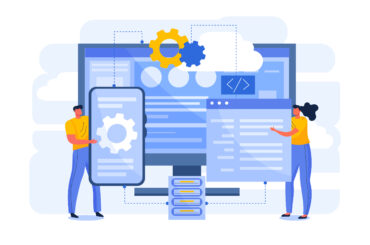Upgrading from Magento 1 to Magento 2: Comprehensive Guide 2023
Last Updated | October 30, 2023
Table of Contents
Are you one of the thousands of store owners who use Magento 1? If so, you’ll want to know about the Magento 2 upgrade. Although it’s not a simple process, it’s worth doing to take advantage of all the new features Magento 2 has to offer. In this article, we’ll walk you through the upgrade process step by step. So don’t wait – start planning your Magento 2 upgrade today!
Why Upgrade Magento 1 to 2 Essential?
There are several reasons why upgrading to Magento 2 is essential:
-
Improved speed and scalability
One of the primary reasons for the inception of Magento 2 was to improve the speed and scalability of the platform. Magento 1 was notorious for being slow, especially when dealing with a large number of products or high traffic volumes. Magento 2 addresses these issues by using a more efficient code structure and improved caching mechanisms. As a result, pages load significantly faster and the overall performance of the site is greatly improved.
-
Better security
Another key reason to upgrade to Magento 2 is for the improved security features. With each new release, Magento addresses a number of known security vulnerabilities. In addition, Magento 2 comes with a number of new features designed to improve the overall security of the platform, such as two-factor authentication and an improved password management system.
-
Enhanced customer experience
Magento 2 also features a number of improvements that enhance the overall customer experience on your site. These include a streamlined checkout process, improved search functionality, and better product page layouts. In addition, Magento 2 provides support for responsive themes out of the box, ensuring that your site looks great on all devices.
-
Improved admin panel
The Magento 2 admin panel is significantly improved over the Magento 1 admin panel. It features a more intuitive design and layout, making it easier to use and navigate. In addition, the new interface provides support for multiple languages, making it easier to manage a multilingual store.
-
New features and functionality
In addition to the improved speed, security, and customer experience, Magento 2 also comes with a number of new features and functionality not found in Magento 1. In addition, Magento 2 introduces a new concept called “Shared Catalogs” which allows businesses to manage multiple storefronts from a single Magento installation.
-
Search engine friendly
Magento 2 is designed to be more search engine friendly than Magento 1. Keyword-rich URLs are now the default, and Meta tags can be generated automatically for products and categories. In addition, Magento 2 includes support for Google Rich Snippets, making it easier for search engines to understand your site’s content and provide accurate search results.
-
Future-proof your business
While Magento 1 will continue to be supported for the foreseeable future, it’s important to keep in mind that eventually support will end. When that happens, you’ll need to upgrade to Magento 2 in order to continue receiving security updates and new features. By upgrading now, you can avoid the last-minute rush and ensure that your business is future-proofed against any changes in the Magento landscape.
A Quick Overview
| Section | Description |
|---|---|
| 1. Introduction | Brief overview of the necessity and benefits of upgrading from Magento 1 to Magento 2. |
| 2. Pre-Upgrade Steps | – Backup: Instructions on backing up data and files.<br> – Compatibility Check: Ensuring server and system requirements. |
| 3. Data Migration | Guidelines on transferring data including products, customers, orders, and other crucial information. |
| 4. Extension Upgrade | Identifying and upgrading compatible extensions, or finding alternatives. |
| 5. Theme and Custom Code Migration | Transitioning themes and customizing codes to be compatible with Magento 2. |
| 6. Testing | Conducting thorough tests to ensure functionality and fix potential issues. |
| 7. Go Live | Steps to take your upgraded Magento 2 site live. |
| 8. Post-Upgrade Support and Maintenance | Guidance on maintaining your Magento 2 store post-upgrade and available support options. |
| 9. Troubleshooting and Common Issues | Tips and solutions for common problems encountered during the upgrade process. |
| 10. Conclusion | Wrapping up the guide and emphasizing the ongoing benefits of Magento 2. |
What Steps Should You Perform to Upgrade Magento 1 to 2?
Magento 2 migration consists of four different stages:
- Theme Migration
- Extension Migration
- Customizations
- Data Migration
Theme Migration
After you’ve installed the new Magento 2 instance, the first step of the migration process is to migrate your theme. This ensures that your store’s design and layout are carried over to the new platform. To do this, you’ll have to create a new theme for Magento 2 and make it responsive for the best user experience.
Once you’ve created your new theme, you’ll need to install it on your Magento 2 store. You can do this by copying the theme files to the /app/design/frontend/Magento/ directory. After you’ve done this, you’ll need to run the following command:
php bin/magento setup:static-content:deploy
This will deploy the new theme on your store and make it available for use.
You can then set your new theme as the default by going to Stores > Configuration > Design in the Magento 2 Admin Panel. From here, you’ll need to select your new theme from the drop-down menu and save your changes.
Now that your theme is migrated, you can start working on migrating your other store data.
Extension Migration
Extension migration is the next step of Magento 2 Migration Process. This step is to migrate your customizations and 3rd party extensions from Magento 1 to Magento 2.
The first thing you’ll need to do is create a list of all the extensions you currently have installed on your Magento 1 store. Once you have that list, you’ll need to research whether or not those extensions are available for Magento 2.
You then need to install relevant Magento 2 extensions from the Magento Marketplace.
Once you’ve installed all the necessary extensions, you’ll need to configure them according to your needs.
Customizations
Now that you have your data migrated, it’s time to start thinking about customizations. This is where things can get a little tricky, because not all customizations are created equal. Some may be relatively simple to port over to Magento 2, while others may require a bit more work. It really depends on the nature of the customization and how it was coded in the first place.
One thing to keep in mind is that Magento 2 uses a different approach to customizations than Magento 1. In Magento 1, customizations were often made directly to the core codebase, which could lead to issues when upgrading to newer versions of the software. Magento 2 employs a “code pool” approach, which allows customizations to be made in separate code pools that are not overwritten when upgrading.
Data Migration
Now that you have successfully migrated your Magento 1 store to Magento 2, the last step is to migrate your data. This includes migrating your customer data, product data, order data, and other data from your Magento 1 store to your new Magento 2 store.
The best way to migrate your data is to use the Magento 2 Data Migration Tool. This tool helps developers migrate their store data and settings using CLI commands. It makes the Magento migration process a breeze.
Does Folio3 Offer Services to Upgrade Magento 1 to 2?
Folio3 offers Magento Development Services that can help you upgrade Magento 1 to 2. As a leading eCommerce development agency, they have the experience and expertise needed to help your business make a smooth transition to the latest version of Magento.
They will work closely with you to ensure that your upgrade goes smoothly and that your store continues to function properly after the upgrade. In addition, they will also provide training and support to help you get the most out of your new Magento 2 store. They also offer Magento 2 Migration, Magento Headless Commerce, and Magento Support Services.
If you want to Hire Magento 2 Developers contact Folio3 today. They will be happy to discuss your options and help you make the best decision for your business.
Conclusion
We hope this guide has been helpful in showing you how to upgrade Magento 1 to 2. While there are a few steps involved, the process is relatively straightforward and should only take a few hours to complete. Once you’ve upgraded, you’ll be able to take advantage of all the new features and benefits that Magento 2 has to offer. Thanks for reading!











